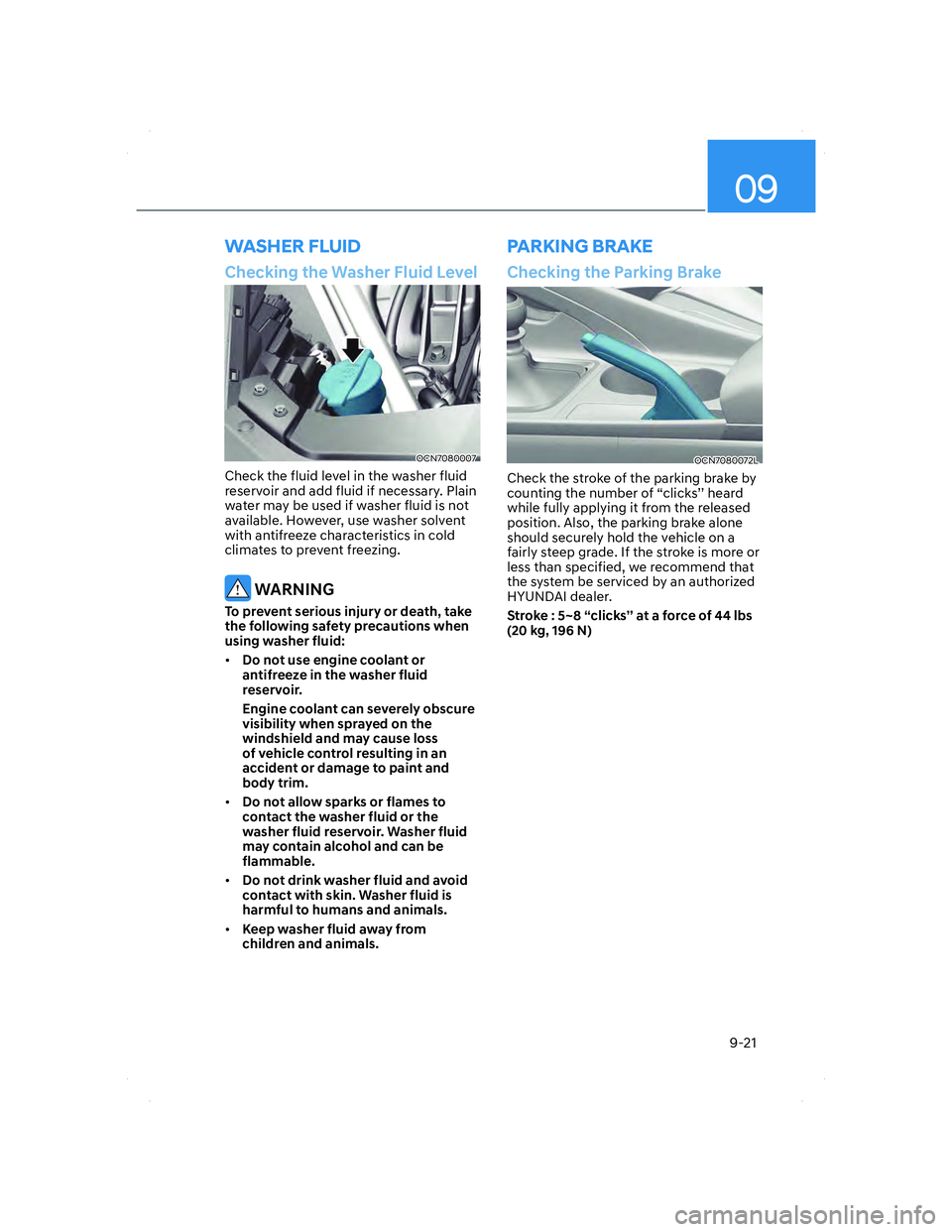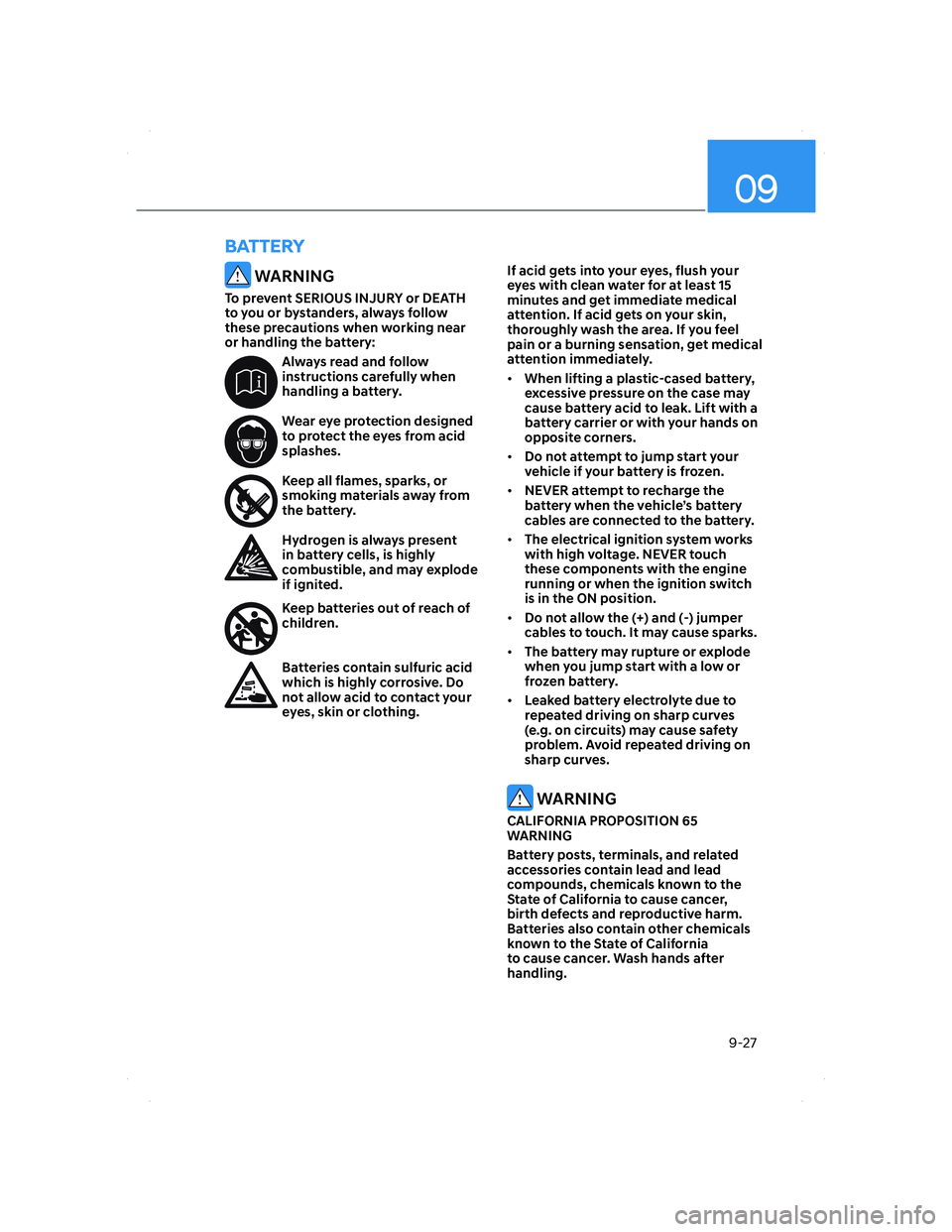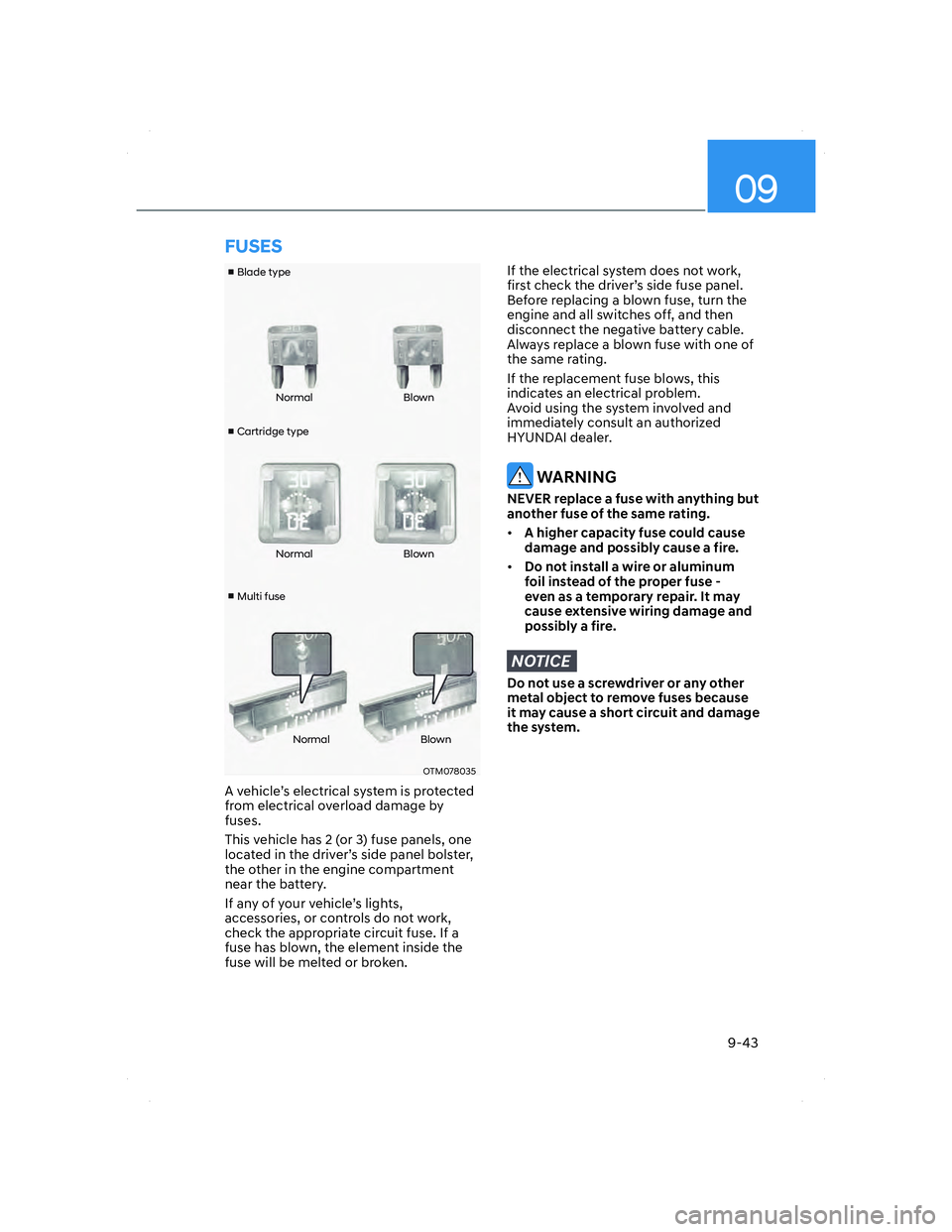Page 518 of 584

09
9-21
PARKING BRAKE
Checking the Washer Fluid Level
OCN7080007OCN7080007
Check the fluid level in the washer fluid
reservoir and add fluid if necessary. Plain
water may be used if washer fluid is not
available. However, use washer solvent
with antifreeze characteristics in cold
climates to prevent freezing.
WARNING
To prevent serious injury or death, take
the following safety precautions when
using washer fluid:
• Do not use engine coolant or
antifreeze in the washer fluid
reservoir.
Engine coolant can severely obscure
visibility when sprayed on the
windshield and may cause loss
of vehicle control resulting in an
accident or damage to paint and
body trim.
• Do not allow sparks or flames to
contact the washer fluid or the
washer fluid reservoir. Washer fluid
may contain alcohol and can be
flammable.
• Do not drink washer fluid and avoid
contact with skin. Washer fluid is
harmful to humans and animals.
• Keep washer fluid away from
children and animals.
WASHER FLUID
Checking the Parking Brake
OCN7080072LOCN7080072L
Check the stroke of the parking brake by
counting the number of “clicks’’ heard
while fully applying it from the released
position. Also, the parking brake alone
should securely hold the vehicle on a
fairly steep grade. If the stroke is more or
less than specified, we recommend that
the system be serviced by an authorized
HYUNDAI dealer.
Stroke : 5~8 “clicks’’ at a force of 44 lbs
(20 kg, 196 N)
CN7 HMA 9.indd 9-212020-12-03 9:42:20
Page 523 of 584
Maintenance
9-26
Front windshield wiper service
positions
OCN7080015OCN7080015
This vehicle has a “hidden” wiper design
which means that the wipers cannot
be lifted when they are in their bottom
resting position.
1. Within 20 seconds of turning off the
engine, lift and hold the wiper lever
up to the MIST position for about 2
seconds until the wipers move to the
top wipe position.
2. At this time you can lift the wipers off
the windshield.
3. Gently put the wipers back down onto
the windshield.
4. Turn the wipers to any ON position
to return the wipers to the bottom
resting position.
OGSR076067OGSR076067
1. Raise the wiper arm.
OGSR076066OGSR076066
2. Lift up the wiper blade clip. Then pull
down the blade assembly and remove
it.
OGSR076068OGSR076068
3. Install the new blade assembly.
4. Return the wiper arm on the
windshield.
CN7 HMA 9.indd 9-262020-12-03 9:42:24
Page 524 of 584

09
9-27
WARNING
To prevent SERIOUS INJURY or DEATH
to you or bystanders, always follow
these precautions when working near
or handling the battery:
Always read and follow
instructions carefully when
handling a battery.
Wear eye protection designed
to protect the eyes from acid
splashes.
Keep all flames, sparks, or
smoking materials away from
the battery.
Hydrogen is always present
in battery cells, is highly
combustible, and may explode
if ignited.
Keep batteries out of reach of
children.
Batteries contain sulfuric acid
which is highly corrosive. Do
not allow acid to contact your
eyes, skin or clothing.If acid gets into your eyes, flush your
eyes with clean water for at least 15
minutes and get immediate medical
attention. If acid gets on your skin,
thoroughly wash the area. If you feel
pain or a burning sensation, get medical
attention immediately.
• When lifting a plastic-cased battery,
excessive pressure on the case may
cause battery acid to leak. Lift with a
battery carrier or with your hands on
opposite corners.
• Do not attempt to jump start your
vehicle if your battery is frozen.
• NEVER attempt to recharge the
battery when the vehicle’s battery
cables are connected to the battery.
• The electrical ignition system works
with high voltage. NEVER touch
these components with the engine
running or when the ignition switch
is in the ON position.
• Do not allow the (+) and (-) jumper
cables to touch. It may cause sparks.
• The battery may rupture or explode
when you jump start with a low or
frozen battery.
• Leaked battery electrolyte due to
repeated driving on sharp curves
(e.g. on circuits) may cause safety
problem. Avoid repeated driving on
sharp curves.
WARNING
CALIFORNIA PROPOSITION 65
WARNING
Battery posts, terminals, and related
accessories contain lead and lead
compounds, chemicals known to the
State of California to cause cancer,
birth defects and reproductive harm.
Batteries also contain other chemicals
known to the State of California
to cause cancer. Wash hands after
handling.
BATTERY
CN7 HMA 9.indd 9-272020-12-03 9:42:24
Page 540 of 584

09
9-43
�v
Cartridge type �v
Blade type
�v
Multi fuseNormal Blown
Normal Blown
Normal Blown
OTM078035OTM078035
A vehicle’s electrical system is protected
from electrical overload damage by
fuses.
This vehicle has 2 (or 3) fuse panels, one
located in the driver’s side panel bolster,
the other in the engine compartment
near the battery.
If any of your vehicle’s lights,
accessories, or controls do not work,
check the appropriate circuit fuse. If a
fuse has blown, the element inside the
fuse will be melted or broken.
If the electrical system does not work,
first check the driver’s side fuse panel.
Before replacing a blown fuse, turn the
engine and all switches off, and then
disconnect the negative battery cable.
Always replace a blown fuse with one of
the same rating.
If the replacement fuse blows, this
indicates an electrical problem.
Avoid using the system involved and
immediately consult an authorized
HYUNDAI dealer.
WARNING
NEVER replace a fuse with anything but
another fuse of the same rating.
• A higher capacity fuse could cause
damage and possibly cause a fire.
• Do not install a wire or aluminum
foil instead of the proper fuse -
even as a temporary repair. It may
cause extensive wiring damage and
possibly a fire.
NOTICE
Do not use a screwdriver or any other
metal object to remove fuses because
it may cause a short circuit and damage
the system.
FUSES
CN7 HMA 9.indd 9-432020-12-03 9:42:26
Page 541 of 584

Maintenance
9-44
Instrument Panel Fuse
Replacement
OCN7080017OCN7080017
1. Turn the vehicle off.
2. Turn all other switches OFF.
3. Open the fuse panel cover.
4. Refer to the label on the inside of
the fuse panel cover to locate the
suspected fuse location.
OCN7080018OCN7080018
5. Pull the suspected fuse straight out.
Use the removal tool provided in the
engine compartment fuse panel.
6. Check the removed fuse; replace it if
it is blown. Spare fuses are provided in
the engine compartment fuse panel.
7. Push in a new fuse of the same
rating, and make sure it fits tightly in
the clips. If it fits loosely, consult an
authorized HYUNDAI dealer.
In an emergency, if you do not have a
spare fuse, use a fuse of the same rating
from a circuit you may not need for
operating the vehicle.
If the other electrical components do
not work and the fuses are undamaged,
check the fuse panel in the engine
compartment. If a fuse is blown, it must
be replaced with the same rating.
If the headlamp, turn signal lamp, tail
lamp, interior lamp doesn’t work and
the fuses are undamaged, consult an
authorized HYUNDAI dealer.
CN7 HMA 9.indd 9-442020-12-03 9:42:27
Page 542 of 584

09
9-45
Engine Compartment Panel Fuse
Replacement
�����„�„Blade type fuseBlade type fuse
OCN7080021OCN7080021
�����„�„Cartridge type fuseCartridge type fuse
OCN7080022OCN7080022
1. Turn the engine off.
2. Turn all other switches OFF.
3. Remove the fuse panel cover by
pressing the tap and pulling up.
4. Check the removed fuse; replace it
if it is blown. To remove or insert the
fuse, use the fuse puller in the engine
compartment fuse panel.
5. Push in a new fuse of the same
rating, and make sure it fits tightly in
the clips. If it fits loosely, consult an
authorized HYUNDAI dealer.
CAUTION
After checking the fuse box in the
engine compartment securely close
the fuse box cover inside the engine
compartment, until it clicks.
If the fuse box is not closed properly,
water may leak in side, possibly causing
a malfunction with the electrical
system.
Multi fuse (Main fuse)
OCN7080020OCN7080020
If the multi fuse is blown, it must be
removed as follows:
1. Turn off the engine.
2. Disconnect the negative battery
cable.
3. Remove the fuse panel cover by
pressing the tab and pulling it up.
4. Remove the nuts shown in the picture
above.
5. Replace the fuse with a new one of
the same rating.
6. Reinstall in the reverse order of
removal.
Information
�,�I���W�K�H���P�X�O�W�L���I�X�V�H���L�V���E�O�R�Z�Q�����F�R�Q�V�X�O�W���D�Q��
�D�X�W�K�R�U�L�]�H�G���+�<�8�1�'�$�,���G�H�D�O�H�U��
CN7 HMA 9.indd 9-452020-12-03 9:42:28
Page 546 of 584
09
9-49
OCN7090014NOCN7090014N
Engine compartment fuse panel
ODN8089017ODN8089017
Inside the fuse/relay box cover, you can
find the fuse/relay label describing fuse/
relay names and ratings.
Information
�1�R�W���D�O�O���I�X�V�H���S�D�Q�H�O���G�H�V�F�U�L�S�W�L�R�Q�V���L�Q���W�K�L�V��
�P�D�Q�X�D�O���P�D�\���E�H���D�S�S�O�L�F�D�E�O�H���W�R���\�R�X�U���Y�H�K�L�F�O�H����
�W�K�H���L�Q�I�R�U�P�D�W�L�R�Q���L�V���D�F�F�X�U�D�W�H���D�W���W�K�H���W�L�P�H���R�I��
�S�U�L�Q�W�L�Q�J�����:�K�H�Q���\�R�X���L�Q�V�S�H�F�W���W�K�H���I�X�V�H���S�D�Q�H�O��
�L�Q���\�R�X�U���Y�H�K�L�F�O�H�����U�H�I�H�U���W�R���W�K�H���I�X�V�H���S�D�Q�H�O��
�O�D�E�H�O��
CN7 HMA 9.indd 9-492020-12-03 9:42:31
Page 547 of 584
![HYUNDAI ELANTRA 2022 Owners Manual Maintenance
9-50
�(�Q�J�L�Q�H���F�R�P�S�D�U�W�P�H�Q�W���I�X�V�H���S�D�Q�H�O
Type Fuse NameFuse Rating Circuit Protected
MULTI
FUSE-3ALT150A
180A[Smartstream G 2.0 Atkinson with AMS2]
Alternator, (Fus HYUNDAI ELANTRA 2022 Owners Manual Maintenance
9-50
�(�Q�J�L�Q�H���F�R�P�S�D�U�W�P�H�Q�W���I�X�V�H���S�D�Q�H�O
Type Fuse NameFuse Rating Circuit Protected
MULTI
FUSE-3ALT150A
180A[Smartstream G 2.0 Atkinson with AMS2]
Alternator, (Fus](/manual-img/35/41167/w960_41167-546.png)
Maintenance
9-50
�(�Q�J�L�Q�H���F�R�P�S�D�U�W�P�H�Q�W���I�X�V�H���S�D�Q�H�O
Type Fuse NameFuse Rating Circuit Protected
MULTI
FUSE-3ALT150A
180A[Smartstream G 2.0 Atkinson with AMS2]
Alternator, (Fuse - ABS1, ABS2, EOP1, POWER
OUTLET1)
[Smartstream G 2.0 Atkinson & Smartstream
G1.6 T-GDi without AMS2] Alternator, (Fuse -
ABS1, ABS2, POWER OUTLET1)
MDPS180A MDPS Unit
MULTI
FUSE-2COOLING
FAN260A [G4FP] Cooling Fan Controller
DCT340A [G4FP] SGA
MULTI
FUSE-1B+560APCB Block (Engine Control Relay, Fuse -
ECU3, ECU4, HORN, WIPER, A/C)
B+160AICU Junction Block (IPS2/IPS5/IPS6/IPS7/
IPS14)
B+260AICU Junction Block (IPS1/IPS4/IPS8/IPS9/
IPS10)
B+350AICU Junction Block (Fuse - TRUNK, AMP,
SAFETY P/WINDOW DRV, P/SEAT DRV, P/
SEAT PASS, S/HEATER FRT, S/HEATER RR,
Long Term Load Latch Relay)
EPB60A ESC Control Module
PTC HEATER50A PTC HEATER
BLOWER40A BLOWER, Multipurpose Check Connector
IG140AE/R Junction Block (PDM (IG1/ACC) Relay),
Ignition Switch
IG240AE/R Junction Block (PDM (IG2) Relay, Start
Relay), Ignition Switch
CN7 HMA 9.indd 9-502020-12-03 9:42:31